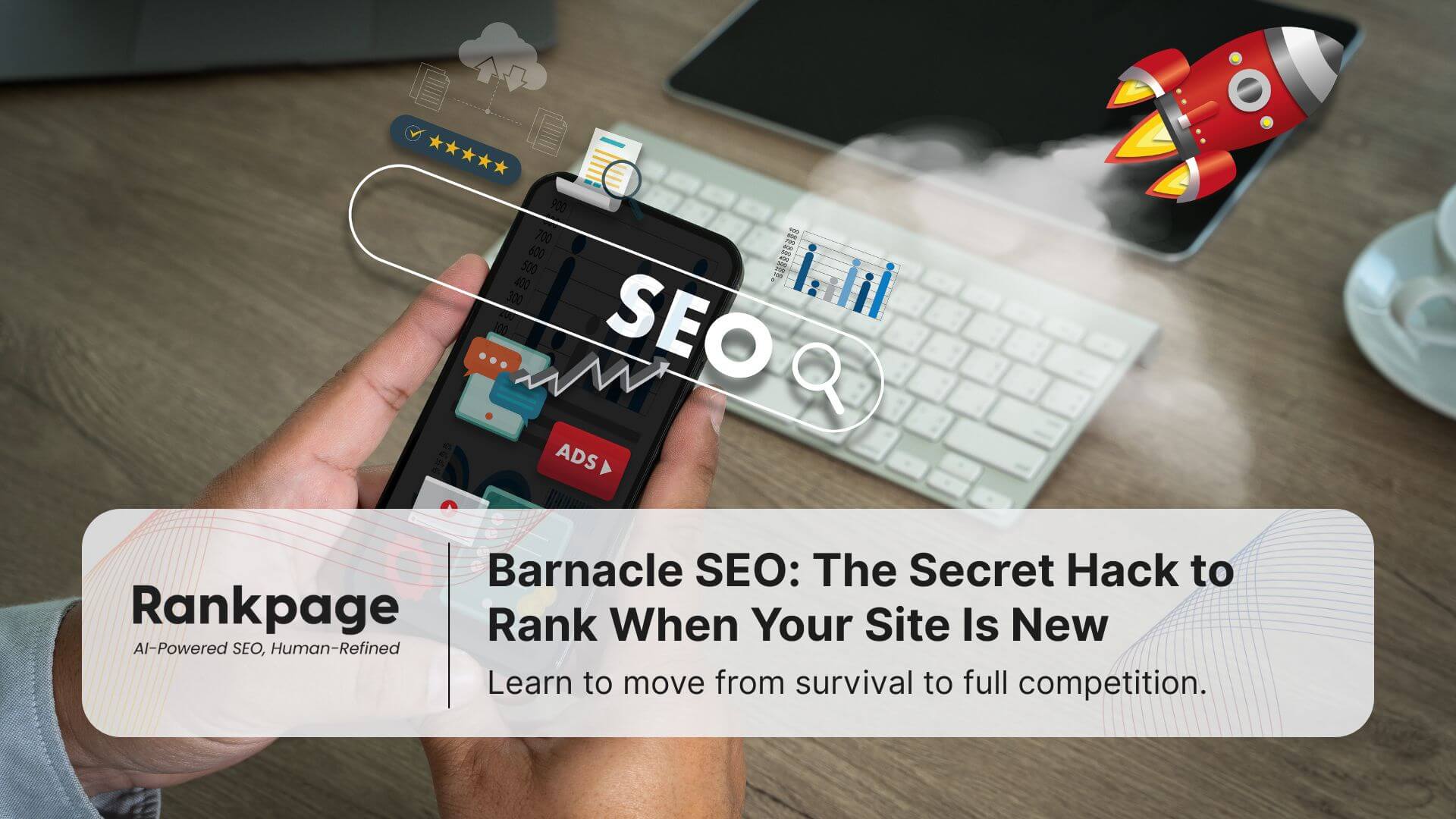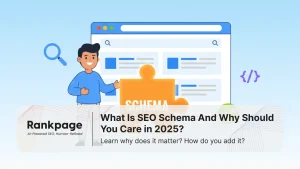Key Takeaways
- Barnacle SEO helps new websites survive by attaching to trusted, high-authority platforms already ranking on Google.
- It delivers fast visibility in competitive niches but does not directly grow your domain authority.
- Tactics include optimising business listings, reviews, aggregator profiles, and social platforms.
- Best used as a short-term survival strategy while you build traditional SEO.
- Over time, you must transition to aggressive SEO to compete directly and scale growth.
Barnacle SEO is a survival strategy for new websites that attach their brand to high-authority sites already ranking, gaining visibility faster without relying only on their own domain.
For businesses launching a new website, breaking onto page one feels impossible when top competitors and directories already occupy all the prime spots.
Enter Barnacle SEO, a clever workaround where instead of fighting head-on, you “ride the authority” of bigger platforms that Google already trusts.
Today, a professional SEO Agency in Malaysia will explain what Barnacle SEO is, why it matters for new sites, the tactics you can use, and when to move from survival to full competition.
Table of Contents
What Is Barnacle SEO?
Barnacle SEO is the practice of attaching your website, brand, or profile to larger platforms that already dominate search results, ensuring you show up where people are already looking.
- The term comes from barnacles clinging to ships, barnacles don’t move on their own, but travel far by attaching to something stronger.
- In SEO terms, the “ships” are:
- Directories (Google Business Profile, Yelp, TripAdvisor)
- Review sites (Clutch, G2, niche industry lists)
- Marketplaces (Amazon, Lazada, Shopee, Fave)
- Social platforms (TikTok, LinkedIn, Xiaohongshu)
- By optimising your presence on these platforms, your brand:
- Appears on page one through third-party authority
- Gains visibility faster than competing head-to-head
- Benefits from the trust these sites already hold with Google
In 2025, Barnacle SEO is even more important because:
- Google’s AI Overviews increasingly cite trusted external platforms.
- Review aggregators and community forums are often pulled into AI summaries.
- Anchoring your brand on these sources improves chances of being referenced in both traditional SERPs and AI-driven search results.
New sites especially, will benefit a lot from Barnacle SEO, which leads us to our next part.
Why Do New Websites Struggle to Rank?
New websites often struggle to rank because they lack authority, backlinks, and trust signals compared to established competitors already dominating page one.
Domain authority takes time to build
- Search engines reward sites with a proven track record of relevance and quality.
- A new domain has no history, so even strong content may take months to surface.
High-competition keywords are already saturated
- Page one for most valuable SEO keywords is occupied by directories, review sites, and long-established businesses.
- Breaking into these results without leverage can take significant time and resources.
Trust signals are missing
- Users and search engines both look for consistent branding, reviews, and external mentions.
- Competitors with years of presence often already have hundreds of reviews and citations.
Better content alone isn’t enough
- Even if a new site publishes excellent articles, a weaker piece on a high-authority platform can still outrank it.
- Why? Because authority and trust weigh heavily in the algorithm.
Search behaviour favours established platforms
- Many users click on map packs, directories, or aggregator results before individual websites.
- According to BrightLocal, 64% of clicks for local service searches go to directories and maps rather than business websites.
“New sites aren’t ignored because their content is bad, they’re ignored because search engines and users don’t yet trust them as much as established alternatives.”
Read more: SEO vs AEO: Optimising for AI in Malaysia (2025)
How Does Barnacle SEO Help New Websites Survive?
Barnacle SEO gives new websites early attention and visibility by attaching their brand to platforms that already rank and hold authority with Google. The worst that can happen to a small and new website, is “disappearing” from Google.
- Leverages existing authority
New websites don’t have domain strength yet. Barnacle SEO allows them to “borrow” the credibility of directories, review sites, and aggregators that already sit on page one. - Faster visibility than organic ranking
Setting up a Google Business Profile or directory listing often gets indexed and ranked in weeks, not months. This helps businesses get seen quickly while their own domain builds traction. - Builds trust by association
Customers often rely on neutral sources, review platforms, map packs, or aggregator sites, more than a brand-new website. Being listed there signals legitimacy. - Expands your SERP footprint
Even if your site isn’t ranking, your brand might still show up in maps, directories, TikTok videos, or deal platforms. Multiple appearances increase the odds of a click. - Positions you for AI Overviews
Google’s AI summaries often pull data from trusted external sources. By anchoring your brand in these places, you boost your chance of being cited in both SERPs and AI-driven answers.
It’s important to say that Barnacle SEO doesn’t replace traditional SEO, it just keeps your business visible while you work on building long-term authority.
What Are the Tactics of Barnacle SEO?
Barnacle SEO works by placing your brand on platforms that already rank, ensuring you appear where customers are looking, even if your own site doesn’t yet.
1. Optimise Business Listings
- Claim and complete your Google Business Profile with reviews, photos, and service details.
- Add consistent NAP (Name, Address, Phone) data across directories like Yelp, TripAdvisor, or Yellow Pages.
- These often show up in the map pack, which attracts the majority of local clicks.
2. Get Featured on Review Sites
- Secure a profile on industry review sites (Clutch, G2, Trustpilot).
- Encourage customers to leave authentic reviews that boost credibility.
- Review platforms are highly trusted and often rank for “best [service/product]” searches.
3. Leverage Aggregators & Marketplaces
- Join deal or aggregator sites relevant to your niche (Fave, Groupon, Klook, Booking.com).
- Marketplaces already rank for high-intent queries, giving you exposure without building it yourself.
4. Publish on High-Authority Platforms
- Repurpose content onto LinkedIn, Medium, or Quora where Google frequently indexes answers and articles.
- Guest posting or thought leadership on niche blogs is another way to ride existing authority.
5. Use Social Platforms That Appear in SERPs
- Short-form video platforms like TikTok, YouTube Shorts, or Xiaohongshu now show up directly in Google results.
- A well-optimised video (geo tags + keyword captions) can barnacle onto competitive queries.
Scenario Example: How Barnacle SEO Works in Practice
All of this can sound overwhelming, so let’s put it in practice!
Imagine launching a new fitness studio website in a crowded Bangsar market, targeting white collar workers nearby after work hours. Ranking for “best workout gyms near me” is nearly impossible at the start. Instead of waiting a year for Local SEO to build, you:
- Claim your Google Business Profile → appear in the local map pack within weeks.
- Run a limited-time deal on Groupon → customers searching “gym promotions” see you instantly.
- Encourage early members to leave reviews on Yelp and TripAdvisor → trusted signals that show up on page one.
- Post workout tips on LinkedIn and TikTok → some of these start ranking for niche queries.
Your studio now appears across multiple search results, even before your website ranks.
That’s Barnacle SEO in action: survival and visibility through association.
Is Barnacle SEO Enough on Its Own?
Barnacle SEO is highly effective for new websites in the short term, but it isn’t a complete replacement for traditional SEO. Here’s why:
It doesn’t grow your domain authority
Your brand may appear on trusted directories and review sites, but your own website doesn’t benefit from those rankings. Long-term success depends on building authority directly on your domain.
You rely on third-party platforms
If a marketplace changes its policies or a directory removes your profile, your visibility can vanish overnight. You don’t control the platforms you’re attached to.
It has limits on scale
Barnacle SEO works well to capture a few competitive keywords, but it can’t cover an entire market. For broader reach, you’ll need your own content and backlinks.
Works best as a complement
Barnacle SEO is most powerful when paired with traditional SEO. It delivers visibility now while you invest in content, technical fixes, and authority-building that will carry you long term.
When Should You Move From Barnacle to Aggressive SEO?
Barnacle SEO is a starting point, not the final destination. Knowing when to shift gears is key to building lasting visibility. Here’s a simple 3-Phase Roadmap for New Websites
Phase | Timeline | Focus | Tactics | Goal |
Phase 1: Ride the Ships | 0–3 months | Visibility | Claim listings, join directories, push reviews, post on social platforms | Appear quickly in SERPs and map packs |
Phase 2: Build Your Own Ship | 3–9 months | Authority | Publish content clusters, optimise on-page SEO, start link acquisition | Strengthen your domain with topical relevance |
Phase 3: Outrank the Ships | 9+ months | Competition | Skyscraper content, digital PR, advanced link-building, technical SEO | Compete directly for high-value keywords |
How to Recognise It’s Time to Transition
- Your business is getting steady traffic from barnacle placements.
- Your site has enough content depth to start attracting backlinks.
- You’re ready to invest in consistent SEO campaigns (content, outreach, technical fixes).
Always start with Barnacle SEO to survive but build traditional SEO to grow, and scale into aggressive tactics once you’re strong enough to compete head-on.
Barnacle SEO: A Survival Strategy, Not the End Goal
Barnacle SEO is one of the smartest ways for new websites to survive in competitive search results.
By attaching your brand to trusted, high-authority platforms, you gain visibility quickly, build credibility, and buy yourself time to grow.
But survival isn’t enough. To truly compete and thrive, you’ll need to transition from short-term tactics into a full SEO strategy that builds authority, content depth, and long-term rankings.
If you’re ready to move beyond survival, partner with Rankpage, Malaysia’s Leading SEO Agency. With over 8 years of SEO expertise, AI-driven optimisation, and proven results, Rankpage offers SEO Services that dominate in Google, AI Overviews, and beyond.
Don’t believe us? Give us a call and we’ll be happy to help you out.
Frequently Asked Questions About Barnacle SEO
What Is Barnacle SEO?
Barnacle SEO is a strategy where new websites attach themselves to high-authority sites already ranking, to gain visibility quickly.
Does Barnacle SEO Work For Small Businesses?
Yes, it’s especially effective for small or new businesses that can’t compete directly with established players on page one.
Is Barnacle SEO Free?
Some tactics like Google Business Profile are free, but premium directories or marketplaces may require paid listings.
What’s The Difference Between Barnacle SEO And Skyscraper SEO?
Barnacle SEO rides existing authority, while Skyscraper SEO builds new content to earn backlinks and authority.
How Long Does Barnacle SEO Take To Show Results?
It can work within weeks, since directories and profiles are indexed quickly, compared to months for traditional SEO.
Can Barnacle SEO replace traditional SEO?
No, it’s a survival tactic. Long-term growth still requires building authority on your own website.





